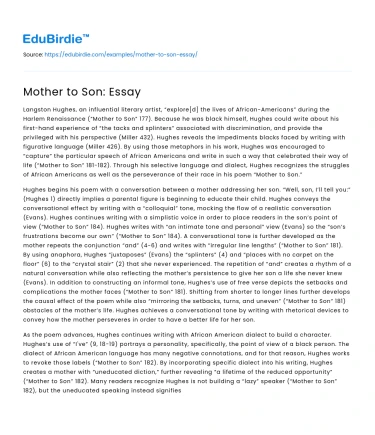Langston Hughes, an influential literary artist, “explore[d] the lives of African-Americans” during the Harlem Renaissance (“Mother to Son” 177). Because he was black himself, Hughes could write about his first-hand experience of “the tacks and splinters” associated with discrimination, and provide the privileged with his perspective (Miller 432). Hughes reveals the impediments blacks faced by writing with figurative language (Miller 426). By using those metaphors in his work, Hughes was encouraged to “capture” the particular speech of African Americans and write in such a way that celebrated their way of life (“Mother to Son” 181-182). Through his selective language and dialect, Hughes recognizes the struggles of African Americans as well as the perseverance of their race in his poem “Mother to Son.”
Hughes begins his poem with a conversation between a mother addressing her son. “Well, son, I’ll tell you:” (Hughes 1) directly implies a parental figure is beginning to educate their child. Hughes conveys the conversational effect by writing with a “colloquial” tone, mocking the flow of a realistic conversation (Evans). Hughes continues writing with a simplistic voice in order to place readers in the son’s point of view (“Mother to Son” 184). Hughes writes with “an intimate tone and personal” view (Evans) so the “son’s frustrations become our own” (“Mother to Son” 184). A conversational tone is further developed as the mother repeats the conjunction “and” (4-6) and writes with “irregular line lengths” (“Mother to Son” 181). By using anaphora, Hughes “juxtaposes” (Evans) the “splinters” (4) and “places with no carpet on the floor” (6) to the “crystal stair” (2) that she never experienced. The repetition of “and” creates a rhythm of a natural conversation while also reflecting the mother’s persistence to give her son a life she never knew (Evans). In addition to constructing an informal tone, Hughes’s use of free verse depicts the setbacks and complications the mother faces (“Mother to Son” 181). Shifting from shorter to longer lines further develops the causal effect of the poem while also “mirroring the setbacks, turns, and uneven” (“Mother to Son” 181) obstacles of the mother’s life. Hughes achieves a conversational tone by writing with rhetorical devices to convey how the mother perseveres in order to have a better life for her son.
Save your time!
We can take care of your essay
- Proper editing and formatting
- Free revision, title page, and bibliography
- Flexible prices and money-back guarantee
As the poem advances, Hughes continues writing with African American dialect to build a character. Hughes’s use of “I've” (9, 18-19) portrays a personality, specifically, the point of view of a black person. The dialect of African American language has many negative connotations, and for that reason, Hughes works to revoke those labels (“Mother to Son” 182). By incorporating specific dialect into his writing, Hughes creates a mother with “uneducated diction,” further revealing “a lifetime of the reduced opportunity” (“Mother to Son” 182). Many readers recognize Hughes is not building a “lazy” speaker (“Mother to Son” 182), but the uneducated speaking instead signifies the missed opportunities of blacks (“Mother to Son” 182), resulting in their own diction. Her effortless dictum may come across as uneducated, but in her ideas, she “embodies the wisdom” of her own race (Evans). Hughes continuously sought to portray the mother’s persistence through her language: “Where there ain’t been no light.” (13). “Ain’t” is commonly seen in our language today as slang, but Hughes utilizes it to build style and further leave “clues” (“Mother to Son” 180) to show how far the mother has come, despite the discrimination she has faced. Hughes’s word choice conveys the darkness the mother has seen as well as how her determination allowed her to overcome her “physical and spiritual” obstacles (“Mother to Son” 179). Her diction is seen again in “finds” (16) as she “warns” her son to not give up if he crosses a difficult path since she has gotten him far in life (“Mother to Son” 180). Hughes uses specific African American language to depict the mother and show her determination of providing a better life for her son.
Through the length of “Mother to Son,” readers can acknowledge Hughes’s desire to recognize the discrimination and hardships of African Americans in the mid-1900s. The poem begins with the mother pronouncing “Life for me ain’t been no crystal stair” (2), indicating that she hasn’t had a perfect life. The crystal stair could represent “dreams that the mother once held” or her “spiritual quest towards heaven” (“Mother to Son” 179). Whatever the indication may be, Hughes intends for the stairway to “connotate smoothness and ease” (“Mother to Son” 179), something many blacks in the twentieth century never got to experience. The mother goes on to explain she’s been “a-climbin’ on” (9) and “sometimes goin’ in the dark” (12), highlighting “the history of African Americans” and their “endless” fight for equality (“Mother to Son” 186). Hughes concludes his poem as the mother motivates her son to not “fall now” (17) because she is “still goin’” (18) and “climbin’” (19). Because the mother has grown up facing hardships, she encourages her son to not fall into the pressures of society since his perseverance will “benefit” their race as a whole (“Mother to Son” 180). The last line of “Mother to Son” repeats the “crystal stair” (20) she never had. This closing line is a final encouragement to the son, pushing him to climb the stairwell in order to find freedom for African Americans and complete the work she started (Miller 432). In summary, Hughes works to include the black race’s hardships in his work.






 Stuck on your essay?
Stuck on your essay?

